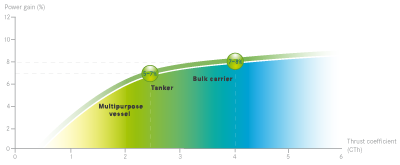- Becker Mewis Duct® – Introduction
- Becker Mewis Duct® – Concept
- Becker Mewis Duct® – Case Study
- Becker Mewis Duct® – CO2 savings
Introduction.
The Becker Mewis Duct® is a power-saving device developed for full-form slower ships that provides either significant fuel savings at a given speed or, alternatively, allows the vessel to travel faster at a given power level.
The Becker Mewis Duct® consists of two strong fixed elements mounted on the vessel: a duct positioned ahead of the propeller together with an integrated fin system within. The duct straightens and accelerates the hull wake into the propeller and also produces a net ahead thrust. The fin system provides a pre-swirl to the ship wake which reduces losses in propeller slipstream, resulting in an increase in propeller thrust at given propulsive power. Both effects contribute to each other.
The achievable power savings from the Becker Mewis Duct® are strongly dependent on propeller thrust loading, from 3% for multi-purpose ships up to 8% for tankers and bulkers. The power savings is virtually independent of ship draught and speed.
The Becker Mewis Duct® is ideally suited to both new-build and retrofit applications (e.g. Tankers, Bulkers and MPCs).
- Improved propulsion
- Proven fuel savings up to 8%
- Reduced greenhouse gases (GHG)
- No moving parts, no service necessary
- Reduced vibrations & pressure pulses
- Return on investment in approx. 1 year
- Installation time approx. 4 days

TOP
|

